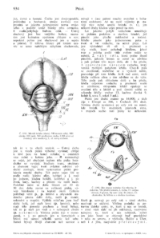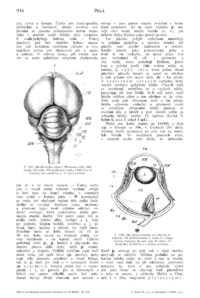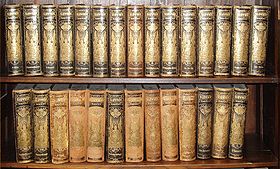
Otto's encyclopedia
Encyclopedia
Otto's encyclopedia published at the turn of the 20th century, is the largest encyclopedia
written in the Czech language
. For its scope and the quality of the writing, it is comparable to the greatest world encyclopedias of its time, such as Encyclopædia Britannica
.

, a Czech book-seller and publisher, began planning a new general Czech
encyclopedia
. He was inspired by the first Czech encyclopedia by F. L. Rieger, a fourteen-volume work published between 1860 and 1874, but wanted to go further. For a long time Otto could not find an eligible editor-in-chief until he began to cooperate with Jan Malý, a former co-editor of the Reiger's encyclopedia, who laid down a concept of the new work with a proposed name - Czech national encyclopedia (Národní encyklopedie česká) in 1884. After Malý's death the following year, Otto found a new editor-in-chief, Tomáš Masaryk
later the president of Czechoslovakia
, and in 1886 the actual work began (Masaryk himself writing the psychology
, sociology
, philosophy
and logic
disciplines). The next year, Masaryk got involved in a tempestuous dispute over the authenticity of the allegedly historical Zelenohorský and Královedvorský manuscripts and resigned from the editorship. Otto managed to establish a new editorial group from prominent technicians, theologians and representatives of Czech universities. Their intensive work and the work of their collaborators lead to the publication of the first volume of the encyclopedia, under the name Ottův slovník naučný (Otto's encyclopedia), in January 1888. From that point onwards, the work progressed without major problems and volumes were published regularly until the last (28th) one appeared in 1908.
Otto's encyclopedia consists of 28 (27 regular plus one supplementary) volumes. It contains approximately 150,000 entries printed on 28,912 pages, using an estimated 130 million letters. There are nearly 5,000 images and illustrations and 479 pages of attachments in the encyclopedia. Around 55 main editors and 1,100 external collaborators participated in its creation.
 Immediately after finishing his encyclopedia, Otto began to plan a second, sixteen-volume revised edition and started to prepare its realization. The preparation was continued by others even after he died (1916) and during the World War I
Immediately after finishing his encyclopedia, Otto began to plan a second, sixteen-volume revised edition and started to prepare its realization. The preparation was continued by others even after he died (1916) and during the World War I
but it was never completed due to quickly rising expenses.
But the story does not end yet. Since the "Jan Otto Ltd." publishing company, which was led by Otto's son-in-law K. B. Mádl, began issuing supplements to the original encyclopedia - the so called Otto's encyclopedia of the new era (Ottův slovník naučný nové doby) - in 1930. These supplements, of very broad conception, were supposed to reflect new pieces of knowledge arising since the first edition was published, new historical events and the new political reality of the freshly born Czechoslovakia
. Most of the entries were completely new, only a minor part of them were revised entries from the first encyclopedia. The Jan Otto company continued to release the supplements until 1934, when it got into financial problems and the work was given over to the "Novina" publishing company. Although the supplements were laid out as a set of 16 volumes, the last two of them, although being ready for printing, never came out, as the whole project was stopped in 1943 by the Nazis
. In 1945, an order not to publish the rest of the encyclopedia came, substantiated by a statement that volumes released during World War II
were severely affected by the Nazi censorship
. (This statement has been disputed since. Jan Havránek, a contemporary Czech historian, states that such censorship interference indeed took place, its range was much more limited than was thought at that time.) Thus, the last released entry of the Otto's encyclopedia of the new era was "Užok" (Uzsok - a village in Hungary
). By an irony of fate, the text of the two last volumes disappeared and the letters V to Z are missing from the encyclopedia till today.
Otto's encyclopedia of the new era is about one third of the size of the original edition. It contains nearly 60,000 entries in 12 volumes printed on 8,585 pages.
The whole project has been re-released between 1996 and 2003. It has also been digitized and appeared in a CD-ROM
version. Both, the paper and digital editions are 'reprints' of the original work, thus preserving the exact look and feel of Otto's encyclopedias.
Otto's encyclopedia demonstrated the progress of Czech society and greatly supported its rising national identity. Even today, it is a good source of information, mainly on historical subjects. Derek Sayer in his book says that "But it is Ottův slovník naučný that remains the greatest of Czech works of reference, unsurpassed by anything published since. In its time it was one of the largest encyclopedias in the world, second in the number of its entries and illustrations perhaps only to the Encyclopædia Britannica
."
Encyclopedia
An encyclopedia is a type of reference work, a compendium holding a summary of information from either all branches of knowledge or a particular branch of knowledge....
written in the Czech language
Czech language
Czech is a West Slavic language with about 12 million native speakers; it is the majority language in the Czech Republic and spoken by Czechs worldwide. The language was known as Bohemian in English until the late 19th century...
. For its scope and the quality of the writing, it is comparable to the greatest world encyclopedias of its time, such as Encyclopædia Britannica
Encyclopædia Britannica
The Encyclopædia Britannica , published by Encyclopædia Britannica, Inc., is a general knowledge English-language encyclopaedia that is available in print, as a DVD, and on the Internet. It is written and continuously updated by about 100 full-time editors and more than 4,000 expert...
.

The first edition
At the beginning of 1880s, Jan OttoJan Otto
Jan Otto was a Czech publisher and bookseller. He is most known for Otto's encyclopedia, the largest encyclopedia published in the Czech language....
, a Czech book-seller and publisher, began planning a new general Czech
Czech language
Czech is a West Slavic language with about 12 million native speakers; it is the majority language in the Czech Republic and spoken by Czechs worldwide. The language was known as Bohemian in English until the late 19th century...
encyclopedia
Encyclopedia
An encyclopedia is a type of reference work, a compendium holding a summary of information from either all branches of knowledge or a particular branch of knowledge....
. He was inspired by the first Czech encyclopedia by F. L. Rieger, a fourteen-volume work published between 1860 and 1874, but wanted to go further. For a long time Otto could not find an eligible editor-in-chief until he began to cooperate with Jan Malý, a former co-editor of the Reiger's encyclopedia, who laid down a concept of the new work with a proposed name - Czech national encyclopedia (Národní encyklopedie česká) in 1884. After Malý's death the following year, Otto found a new editor-in-chief, Tomáš Masaryk
Tomáš Masaryk
Tomáš Garrigue Masaryk , sometimes called Thomas Masaryk in English, was an Austro-Hungarian and Czechoslovak politician, sociologist and philosopher, who as an eager advocate of Czechoslovak independence during World War I became the founder and first President of Czechoslovakia, also was...
later the president of Czechoslovakia
Czechoslovakia
Czechoslovakia or Czecho-Slovakia was a sovereign state in Central Europe which existed from October 1918, when it declared its independence from the Austro-Hungarian Empire, until 1992...
, and in 1886 the actual work began (Masaryk himself writing the psychology
Psychology
Psychology is the study of the mind and behavior. Its immediate goal is to understand individuals and groups by both establishing general principles and researching specific cases. For many, the ultimate goal of psychology is to benefit society...
, sociology
Sociology
Sociology is the study of society. It is a social science—a term with which it is sometimes synonymous—which uses various methods of empirical investigation and critical analysis to develop a body of knowledge about human social activity...
, philosophy
Philosophy
Philosophy is the study of general and fundamental problems, such as those connected with existence, knowledge, values, reason, mind, and language. Philosophy is distinguished from other ways of addressing such problems by its critical, generally systematic approach and its reliance on rational...
and logic
Logic
In philosophy, Logic is the formal systematic study of the principles of valid inference and correct reasoning. Logic is used in most intellectual activities, but is studied primarily in the disciplines of philosophy, mathematics, semantics, and computer science...
disciplines). The next year, Masaryk got involved in a tempestuous dispute over the authenticity of the allegedly historical Zelenohorský and Královedvorský manuscripts and resigned from the editorship. Otto managed to establish a new editorial group from prominent technicians, theologians and representatives of Czech universities. Their intensive work and the work of their collaborators lead to the publication of the first volume of the encyclopedia, under the name Ottův slovník naučný (Otto's encyclopedia), in January 1888. From that point onwards, the work progressed without major problems and volumes were published regularly until the last (28th) one appeared in 1908.
Otto's encyclopedia consists of 28 (27 regular plus one supplementary) volumes. It contains approximately 150,000 entries printed on 28,912 pages, using an estimated 130 million letters. There are nearly 5,000 images and illustrations and 479 pages of attachments in the encyclopedia. Around 55 main editors and 1,100 external collaborators participated in its creation.
Otto's encyclopedia of the new era

World War I
World War I , which was predominantly called the World War or the Great War from its occurrence until 1939, and the First World War or World War I thereafter, was a major war centred in Europe that began on 28 July 1914 and lasted until 11 November 1918...
but it was never completed due to quickly rising expenses.
But the story does not end yet. Since the "Jan Otto Ltd." publishing company, which was led by Otto's son-in-law K. B. Mádl, began issuing supplements to the original encyclopedia - the so called Otto's encyclopedia of the new era (Ottův slovník naučný nové doby) - in 1930. These supplements, of very broad conception, were supposed to reflect new pieces of knowledge arising since the first edition was published, new historical events and the new political reality of the freshly born Czechoslovakia
Czechoslovakia
Czechoslovakia or Czecho-Slovakia was a sovereign state in Central Europe which existed from October 1918, when it declared its independence from the Austro-Hungarian Empire, until 1992...
. Most of the entries were completely new, only a minor part of them were revised entries from the first encyclopedia. The Jan Otto company continued to release the supplements until 1934, when it got into financial problems and the work was given over to the "Novina" publishing company. Although the supplements were laid out as a set of 16 volumes, the last two of them, although being ready for printing, never came out, as the whole project was stopped in 1943 by the Nazis
Nazism
Nazism, the common short form name of National Socialism was the ideology and practice of the Nazi Party and of Nazi Germany...
. In 1945, an order not to publish the rest of the encyclopedia came, substantiated by a statement that volumes released during World War II
World War II
World War II, or the Second World War , was a global conflict lasting from 1939 to 1945, involving most of the world's nations—including all of the great powers—eventually forming two opposing military alliances: the Allies and the Axis...
were severely affected by the Nazi censorship
Censorship
thumb|[[Book burning]] following the [[1973 Chilean coup d'état|1973 coup]] that installed the [[Military government of Chile |Pinochet regime]] in Chile...
. (This statement has been disputed since. Jan Havránek, a contemporary Czech historian, states that such censorship interference indeed took place, its range was much more limited than was thought at that time.) Thus, the last released entry of the Otto's encyclopedia of the new era was "Užok" (Uzsok - a village in Hungary
Hungary
Hungary , officially the Republic of Hungary , is a landlocked country in Central Europe. It is situated in the Carpathian Basin and is bordered by Slovakia to the north, Ukraine and Romania to the east, Serbia and Croatia to the south, Slovenia to the southwest and Austria to the west. The...
). By an irony of fate, the text of the two last volumes disappeared and the letters V to Z are missing from the encyclopedia till today.
Otto's encyclopedia of the new era is about one third of the size of the original edition. It contains nearly 60,000 entries in 12 volumes printed on 8,585 pages.
The whole project has been re-released between 1996 and 2003. It has also been digitized and appeared in a CD-ROM
CD-ROM
A CD-ROM is a pre-pressed compact disc that contains data accessible to, but not writable by, a computer for data storage and music playback. The 1985 “Yellow Book” standard developed by Sony and Philips adapted the format to hold any form of binary data....
version. Both, the paper and digital editions are 'reprints' of the original work, thus preserving the exact look and feel of Otto's encyclopedias.
Otto's encyclopedia demonstrated the progress of Czech society and greatly supported its rising national identity. Even today, it is a good source of information, mainly on historical subjects. Derek Sayer in his book says that "But it is Ottův slovník naučný that remains the greatest of Czech works of reference, unsurpassed by anything published since. In its time it was one of the largest encyclopedias in the world, second in the number of its entries and illustrations perhaps only to the Encyclopædia Britannica
Encyclopædia Britannica
The Encyclopædia Britannica , published by Encyclopædia Britannica, Inc., is a general knowledge English-language encyclopaedia that is available in print, as a DVD, and on the Internet. It is written and continuously updated by about 100 full-time editors and more than 4,000 expert...
."
External links
- Ottův slovník naučný (1-27) free download in various formats
- Homepage of the CDROM edition of Otto's encyclopedia
- coto.je - "What Is It" - an online version of three Czech encyclopedias including Otto's (Czech only)

